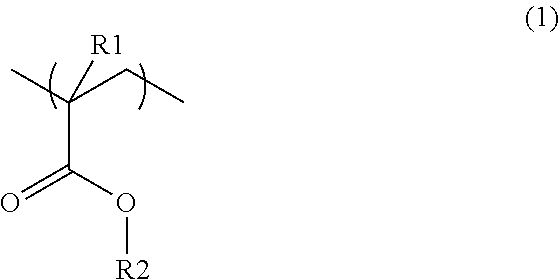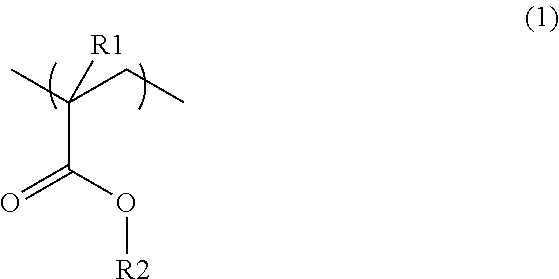Synthetic resin laminate
a technology of synthetic resin and laminate, applied in the direction of synthetic resin layered products, transportation and packaging, chemistry apparatus and processes, etc., can solve the problems of easy cracking of the acrylic resin layer on the other side of the laminate, and the laminate may often warp, and achieve excellent form stability
- Summary
- Abstract
- Description
- Claims
- Application Information
AI Technical Summary
Benefits of technology
Problems solved by technology
Method used
Image
Examples
synthesis example 1
Production of Vinyl Copolymer Resin (A1)
[0065]A monomer composition containing 77.000 mol % of purified methyl methacrylate (by Mitsubishi Gas Chemical), 22.998 mol % of purified styrene (by Wako Pure Chemical Industries) and 0.002 mol % of a polymerization initiator, t-amyl peroxy-2-ethylhexanoate (by Arkema Yoshitomi, trade name: Luperox 575) was continuously fed into a 10-liter complete mixing tank equipped with a helical ribbon blade at a feeding rate of 1 kg / hr, and continuously polymerized at a polymerization temperature of 150° C. for a mean residence time of 2.5 hours. The liquid was continuously discharged out through the bottom of the tank so that the liquid level in the polymerization tank could be all the time constant, and introduced into a solvent removal unit to give pellets of a vinyl copolymer resin (A1).
[0066]The obtained vinyl copolymer resin (A1′) was dissolved in methyl isobutyrate (by Kanto Chemical) to prepare a 10 mas % methyl isobutyrate solution. 500 parts ...
synthesis example 2
Production of Vinyl Copolymer Resin (A2)
[0067]A vinyl copolymer resin (A2) was produced in the same manner as in Synthesis Example 1 except that the amount of methyl methacrylate used in Synthesis Example 1 was changed to 50.000 mol % and the amount of styrene was to 49.998 mol %. As a result of measurement through 1H-NMR, the proportion of the methyl methacrylate structural unit in the vinyl copolymer resin (A2) was 48 mol %. As a result of absorptiometry at a wavelength of 260 nm, the hydrogenation ratio at the aromatic double bond site was 99%. The weight-average molecular weight (equivalent to standard polystyrene) of the resin, as measured through gel permeation chromatography, was 170,000.
synthesis example 3
Production of Vinyl Copolymer Resin (A3)
[0068]A vinyl copolymer resin (A3) was produced in the same manner as in Synthesis Example 1 except that the amount of methyl methacrylate used in Synthesis Example 1 was changed to 60.019 mol % and the amount of styrene was to 39.979 mol %. As a result of measurement through 1H-NMR, the proportion of the methyl methacrylate structural unit in the vinyl copolymer resin (A3) was 58 mol %. As a result of absorptiometry at a wavelength of 260 nm, the hydrogenation ratio at the aromatic double bond site was 99%. The weight-average molecular weight (equivalent to standard polystyrene) of the resin, as measured through gel permeation chromatography, was 155,000.
PUM
| Property | Measurement | Unit |
|---|---|---|
| humidity | aaaaa | aaaaa |
| temperature | aaaaa | aaaaa |
| mol % | aaaaa | aaaaa |
Abstract
Description
Claims
Application Information
 Login to view more
Login to view more - R&D Engineer
- R&D Manager
- IP Professional
- Industry Leading Data Capabilities
- Powerful AI technology
- Patent DNA Extraction
Browse by: Latest US Patents, China's latest patents, Technical Efficacy Thesaurus, Application Domain, Technology Topic.
© 2024 PatSnap. All rights reserved.Legal|Privacy policy|Modern Slavery Act Transparency Statement|Sitemap



